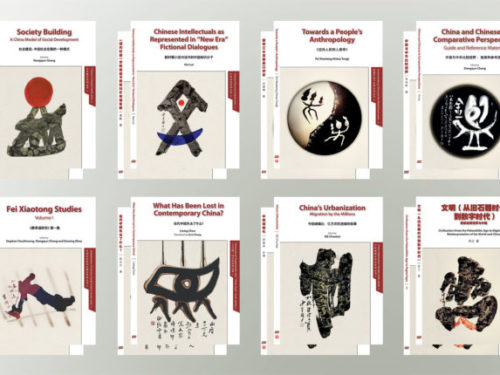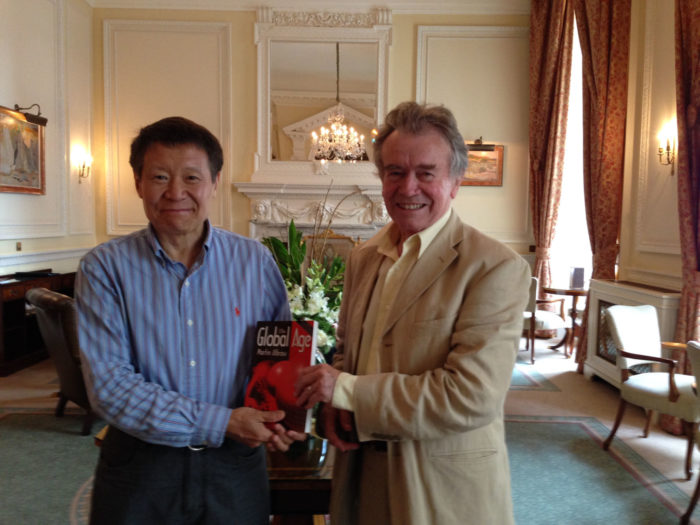

On July 20, 2014, Professor LI Qiang (1950-2023), then Dean of the School of Social Sciences at Tsinghua University, traveled to the UK for a vacation with his wife, Zhang Hua [Note 1]. As a friend, I had arranged their 10-day itinerary in advance and accompanied them in London. Unfortunately, due to Mrs. Zhang catching a cold and developing a fever, they had to cut their vacation short and rescheduled their return flight on the afternoon of the 24th. This left many regrets but also provided me with unforgettable and wonderful memories. The following is a record of some of their visit.
On July 20th (Sunday), the Li couple arrived at London Heathrow Airport at 15:10 on flight BA38, then proceeded to check in at the Hilton London Hotel (located on Edgware Road but quite far from Edgware Station, which is near my home). A BBC Prom concert was arranged at 19:30 at the Royal Albert Hall, where the World Peace Orchestra, consisting of musicians from around the world, performed classical pieces by composers such as Beethoven and Mozart, as well as some music themed around world peace, expressing the harmonious coexistence of different cultures and nations through various famous pieces. Unfortunately, due to jet lag and fatigue, the Lis were unable to attend, so I and other friends appreciated it on their behalf.
On July 21st (Monday), we took a day trip to Wisley Gardens. On this day, the Li couple joined an activity that I had previously arranged with two friends. Wisley Gardens, part of the Royal Horticultural Society (RHS), is located 23 miles southwest of the Royal Botanic Gardens, Kew, in Surrey. It is one of the gardens owned and managed by the RHS and is considered one of the most influential horticultural gardens in the world. With its diverse plant collections, exquisite garden designs, and deep horticultural traditions, it has become a sanctuary for garden enthusiasts both in the UK and globally.

The first set of photos features some flowers I had never seen before (from left to right): Artichoke (Cynara cardunculus), a member of the thistle family originally from the Mediterranean region. The unopened flower buds are edible, and the open flowers are bright purple, valued for both their ornamental and economic qualities; Vanda, renowned for its large, colorful flowers, with this particular Vanda sporting purple spots, making it highly ornamental; Bird of Paradise (Strelitzia reginae), known for its unique shape and vibrant colors, with this plant displaying a combination of red, yellow, and green, making it very eye-catching; Spider Orchid (Brassia), named for its unique flower shape, with long, spidery petals and sepals; Spiral Ginger (Alpinia zerumbet), noted for its unique spiral stems and decorative leaves, widely used for ornamental purposes.
The next set of photos (from left to right): We encountered a Chinese pavilion called the ‘Butterfly Lovers Pavilion’ in Wisley Gardens. It was built in 2005 through a collaboration between the Shanghai Botanical Garden in China and the RHS. Initially designed for the Hampton Court Palace Flower Show that year, where it won a silver medal, the pavilion was later donated to Wisley Gardens as a permanent feature. The pavilion’s design was inspired by the classic Chinese love story ‘The Butterfly Lovers’ (Liang Shanbo and Zhu Yingtai). The design and construction were led by Professor LIU Tingfeng from the Landscape Design Department at Tianjin University, China. To commemorate the story, the pavilion’s six pillars are carved with butterfly motifs, symbolizing the transformation of the lovers into butterflies at the end of the legend. The construction materials were sourced from Zhejiang to ensure the pavilion’s authentic Chinese architectural style. The pavilion was built to celebrate Sino-British cooperation in horticulture and to introduce traditional Chinese garden art to Wisley Gardens, offering visitors a unique blend of Eastern and Western cultural experiences. The pavilion was designed and built by Chinese horticulturists and craftsmen who ensured that it seamlessly blended into Wisley Gardens’ natural environment.
As we were leaving Wisley Gardens, we took commemorative photos with my friends and Professor Li and his wife respectively.
On July 22nd (Tuesday), we spent a day touring central London.
We had arranged to meet Professor Martin Albrow, former president of the British Sociological Association, for lunch at 12:30, so our schedule was quite tight. Early in the morning, we took the Tube to the Tower of London and Tower Bridge. Due to time constraints, we didn’t enter but toured the area before boarding a sightseeing boat along the Thames towards Westminster (see following photos).

At Westminster Pier, we walked along Downing Street (with No. 10 being the official residence of the British Prime Minister), passing by Horse Guards Parade, Horse Guards Arch, and other sites, where we witnessed the Changing of the Guard (see following photos).
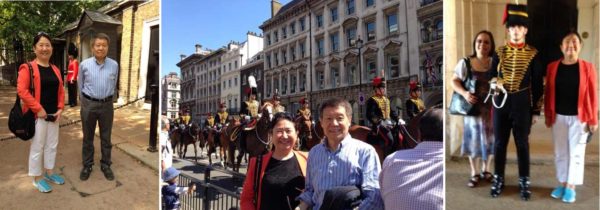
Afterward, we arrived at Trafalgar Square. Professor Li was particularly interested in the four bronze lion statues at the base of Nelson’s Column, one of Trafalgar Square’s most iconic features. He asked me to take a photo of him and his wife with one of the lions as the background. The contrast between the massive lion and the ‘small’ figures of the Lis in the photo led me to reflect. The lion, a symbol of strength, courage, and dignity in many cultures, perhaps served as a confirmation of self-identity and pride.
We were also intrigued by the blue rooster sculpture on the Fourth Plinth in the square. The Fourth Plinth was originally designed for a statue of King William IV, but due to funding issues, the statue was never completed. In 1999, the Fourth Plinth Project was launched, turning it into a platform for displaying contemporary art, with a new piece being installed every few years. The sculpture, titled ‘Hahn/Cock,’ was created by German artist Katharina Fritsch. Its bold color and form sparked widespread discussion and interest. The blue rooster symbolizes male strength and courage, while also carrying a satirical tone that questions the solemnity of traditional monuments. Fritsch described it as a humorous satire, challenging the gravity of other traditional statues in the square, making it a prime example of contemporary art in public spaces (see following photos).
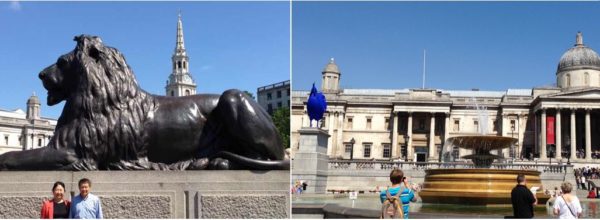
After leaving the square, Professor Li suggested visiting The British Academy. Founded in 1902, The British Academy is a national academic institution established to promote and support research in the humanities and social sciences. Its primary goal is to promote high standards of academic research, encourage scholarly debate, and support research that enhances understanding of human and social issues. The Academy is not open to the public, and one can only enter by attending an event or participating in a meeting. After taking a photo at the entrance, Professor Li suggested that we should organize events here in the future. [Note 2].
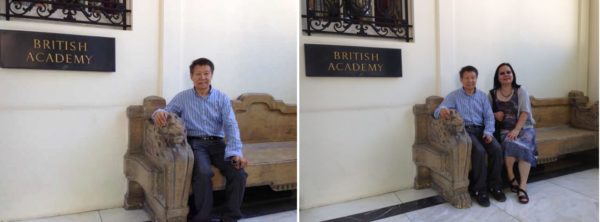
Our lunch with Martin Albrow was held at the Royal Automobile Club (RAC). This is one of Britain’s top private members’ clubs, offering dining, accommodation, fitness facilities, social events, and business meeting spaces. The RAC’s dining services are renowned for their high quality and exquisite cuisine, making it a key part of London’s high-end social life. Martin accompanied Professor Li and his wife on a tour of the club, where we exchanged ideas in the garden. After lunch, Martin presented Professor Li with his award-winning book, The Global Age (see following photos) [Note 3].

After lunch, we strolled through London and visited the London School of Economics, where we met with Dr. LIU Jiayan, a visiting fellow from Tsinghua University’s School of Architecture. She was conducting postdoctoral research under Professor Li’s supervision (see following photos). [Note 4]

We managed to be among the last visitors admitted to the British Museum before closing at 4 p.m. Professor Li asked me to take another photo of them in front of a large Assyrian lion relief. This famous Assyrian stone relief, likely from the ancient city of Nineveh, depicts scenes from the ‘Assyrian Lion Hunt,’ symbolizing the power and majesty of the Assyrian Empire. This photo again illustrates Professor Li’s identification with the symbolic attributes of the lion.
In the China Collection, we saw a large scroll painting (unfortunately, we did not photograph the exhibit label). The painting depicted landscapes, featuring mountains, rivers, and pine trees, intended to convey the artist’s reverence for nature and to express a sense of tranquility and harmony. In passing, I mentioned the idea of expanding the ‘China in Comparative Perspective’ approach at the London School of Economics to include a global perspective. This would not only involve comparing China with other countries and regions on a global scale but also conducting a comprehensive comparative study of China’s social transformations from past to present within a historical context. Methodologically speaking, the essential difference between the social science research conducted by Chinese scholars and that of their Western counterparts can be understood by grasping the essence of a Chinese scroll painting. [Note 5]
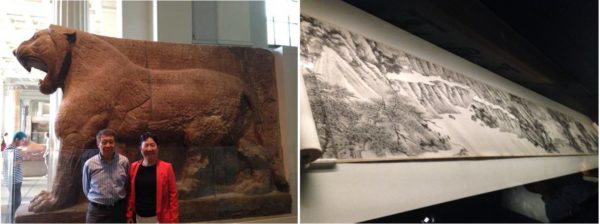
On July 23rd (Wednesday), the Li couple took a day trip to Windsor on their own, departing from Waterloo Station. They conducted a detailed tour of Windsor Castle. After their return to London, Mrs. Zhang developed a fever, and they decided to reschedule their flight to return to China early.
On July 24th (Thursday), the original plan was to go on a walk in the woods near my home and have an academic discussion, but due to their flight departing from Heathrow Airport at 16:45, we skipped the walk. Instead, we had a morning tea chat and lunch. The following photos were taken by Professor Li. At that time, taking photos and shared via WeChat was not very common, so we didn’t take a group photo, but there were individual photos of Mrs Zhang with my mother and me.
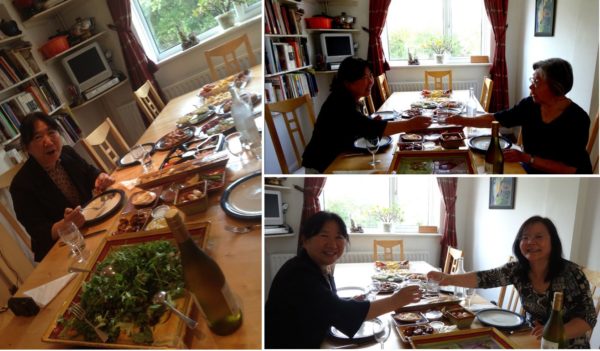
At around 2 pm., we met with LIU Jiayan and her son at Heathrow Airport’s Terminal 2. The child happily and proactively pushed the luggage cart, which everyone admired as a good educational approach. Before parting, we took a group photo in front of a colorful painting advertisement. Reflecting later, this photo carried profound and personal significance, symbolizing academic exchange, friendship, educational inheritance, and family bonds. It recorded an important moment in the scholars’ professional and personal lives, demonstrating their commitment to knowledge, nurturing students, and cherishing family.
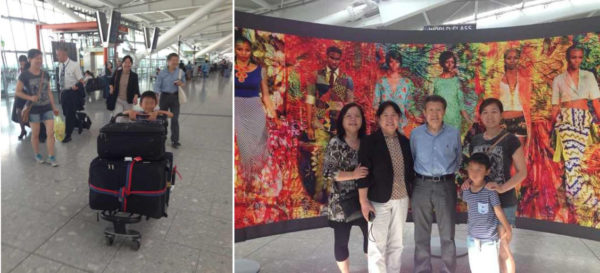
Notes:
- [1] In July 2014, Li Qiang was elected President of the Chinese Sociological Association. He was the sixth president since the association’s founding in 1979, following Fei Xiaotong, YUAN Fang, LU Xueyi, ZHENG Hangsheng, and LI Peilin. This blog was updated after visits by Tsinghua University’s School of Social Sciences and other universities in Beijing and Shanghai to the UK in July-August 2024.
- [2] Starting in 2015, the second to the eighth Global China Dialogue series were all held at this location until 2023.
- [3] Li Qiang also served as the Honorary Chinese President of the Global China Institute (alongside Martin). After the institute was renamed the Global China Academy and restructured into a worldwide fellowship, Li Qiang served as the Chinese chair of the Academy’s Council, alongside Professor Tony McEnery, former Interim Chief Executive of the UK’s Economic and Social Research Council (ESRC), which is equivalent to China’s National Philosophy and Social Sciences Foundation.
- [4] Professor Li, together with Mr. LI Tie, former Director of the China Center for Urban Development and Small Towns Reform, co-edited the ‘China Urbanization Studies Series,’ published by Global Century Press, with Dr. Liu serving as the Executive Editor.
- [5] Xiangqun Chang, Guanxi or Li shang wanglai? Reciprocity, Social Support Networks, & Social Creativity in a Chinese Village (Scholarly Publishing Business, Airiti Press Inc. 2010; Chinese editions 2009 and 2010): ‘In 2005 there was an exhibition of “China: Three Emperors (1662–1795)”. David Hockney, the Fellow of The Royal Academy of Arts, commented that the Chinese paintings deployed multiple perspective points in a single painting, which is different from the single perspective point in Western painting. For him, Western history of art has long neglected the beauty and sophistication of the Chinese scroll painting (A typical example is the Qingming Riverside Painting)’. From Hockney’s point of view, the scroll painting ‘bears close resemblance to cinema pictures by offering a sense of pleasure at being part of the painting. As the Chinese painting has no vanishing point, its viewer has to assume a participatory approach, rather than a static posture, through which to engage him or herself, including eyes, body and psyche into the story-telling and moving with the scroll part by part” (David Hockney, “A Difference of Perspective”, in “Three Emperors, 1662–1795”, RA Magazine, Winter, 2005). Chang believes that western social science is more focused on a detailed analysis of specific issues, while the Chinese way is to offer a combined approach to several issues together. Her ‘book is an attempt to present to its readers a huge scroll painting of the complicated relationships in the everyday life of a Chinese village. It is nonetheless not totally Chinese, just as sometimes in the West a few miniatures can be presented on one big wall. In this case they are embedded in the Chinese scroll. Hockney’s prescription of how to appreciate Chinese painting might be helpful for readers in their approach to this book’ (Chang, 2010, p42-43).
Xiangqun Chang, originally posted on July 30, 2014; updated on August 30, 2024.
Related pages:
- Click here to the Chinese page.
- Click here to view the page ‘GCA Life Fellow Korean Sociologist Professor HAN Sang-Jin Meeting Professor Xiangqun Chang at Seoul, January 2023.’
- Click here to the news ‘The Chinese Chair of the Global China Aacademy Council, Professor LI Qiang, passed away on the 12 December, 2023’.
- Click here to watch a video of Professor LI Qiang’s greeting for the launch of the Global China Academy as an academy at the 7th Global China Dialogue, on December 10th, 2021, at the British Academy.
- Click here to visit News and Blog.



